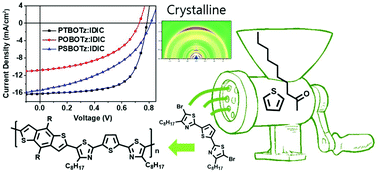Alkylthiazole-based semicrystalline polymer donors for fullerene-free organic solar cells†
Abstract
Fullerene-free organic solar cells (FF-OSCs) composed of a wide-bandgap polymer donor (PD) and a small-bandgap organic small-molecule acceptor (SMA) are currently showing promising power conversion efficiency with good long-term stability. Herein, we synthesized three kinds of electron deficient alkylthiazole-based PDs for FF-OSCs. The synthesized 2,5-bis(5-bromo-4-octylthiazol-2-yl)thiophene (OTz) monomer has a simple conjugated backbone structure composed of thiophene and thiazole rings and is easily synthesized from relatively cheap starting materials, thiophene and 2-decanone, with an overall yield of 48%. To evaluate the photovoltaic properties of the OTz moiety, it is copolymerized with several benzodithiophene-based comonomers. All of the PDs are semicrystalline because of the highly planar backbone structure of OTz. Among them, the PTBOTz polymer exhibits superior absorption, hole mobility and charge separation properties, and thus the photovoltaic device based on PTBOTz and the SMA exhibited the best PCE of 8.32% with excellent thermal stability. Analyzing the nanomorphology and charge separation and transport properties of the PDs and SMA, we found that sizable crystallinity without severe molecular aggregation in blend films is critical to improving the PCE as well as the thermal stability of FF-OSCs.



 Please wait while we load your content...
Please wait while we load your content...